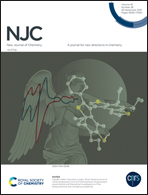Activity manifestation via architectural manipulation by cubic silica-derived Co3O4 electrocatalysts towards bifunctional oxygen electrode performance†
Abstract
Electrocatalytic water splitting reaction utilizing non-renewable energy resources significantly leads to a sustainable energy infrastructure. Highly efficient bifunctional catalysts for oxygen reduction and oxygen evolution reactions (ORR/OER) are essential for the replacement of platinum, ruthenium and iridium metals. We used four different silica templates to create excellent mesoporous cobalt oxide (Co3O4) electrocatalysts in crystalline form. Various advanced techniques confirm the spinel structure composed of both Co3+ and Co2+ sites, which lead to an enhanced surface area, mesoporosity, and a rod morphology with a cubic-like network structure. Among these replicas, the Mobil composition of matter (MCM)-48-derived Co3O4 (Co3O4-M8) material demonstrates remarkable OER activity with an observed potential of 1.76 V, a Tafel slope of 107 mV dec−1 and a lower charge transfer resistance. Such a high performance is observed due to assistance of the Co3+ to Co4+ transition during the oxygen evolution reaction. The ORR was more active on the Korea advanced institute of science and technology (KIT)-6-derived Co3O4 (Co3O4-K6) material, which displayed a more positive onset potential of 0.85 V, a half-wave potential of 0.56 V and a better current density in alkaline medium. In addition, we found that the stabilization of Co2+ active sites in the Co3O4-K6 material is the reason for the enhanced oxygen reduction reaction. The observed bifunctional activity (ΔE = EOER@10 mA cm−2 − ORR@E1/2) for the Co3O4-K6 catalyst is 1.22 V, which shows significant performance among all the catalysts prepared in this work. Such an earth-abundant mesoporous Co3O4 catalyst obtained via an environmentally benign process is anticipated to revolutionize electrochemical energy conversion and storage devices.



 Please wait while we load your content...
Please wait while we load your content...